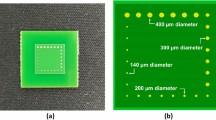Abstract
The impact reliability of solder joints in electronic packages is critical to the lifetime of electronic products, especially those portable devices using area array packages such as ball-grid array (BGA) and chip-scale packages (CSP). Currently, SnAgCu (SAC) solders are most widely used for lead-free applications. However, BGA and CSP solder joints using SAC alloys are fragile and prone to premature interfacial failure, especially under shock loading. To further enhance impact reliability, a family of SAC alloys doped with a small amount of additives such as Mn, Ce, Ti, Bi, and Y was developed. The effects of doping elements on drop test performance, creep resistance, and microstructure of the solder joints were investigated, and the solder joints made with the modified alloys exhibited significantly higher impact reliability.
Similar content being viewed by others
References
C. Chiu et al., Proc. 54th Electronic Components and Technology Conference, vol. 2 (Piscataway, NJ: IEEE, June 2004), pp. 1256–1262.
M. Date et al., in Ref. 1, pp. 668–674.
D. Henderson, “On the Question of SAC Solder Alloy-Cu Pad Solder Joint Fragility” (Presentation at Universal Instruments Consortium on SAC Solder Joint Fragility, Binghamton, NY, September 2004).
T. Gregorich et al., “SnNi and SnNiCu Intermetallic Compounds Found When Using SnAgCu Solders” (Presentation at the IPC/Soldertec Global 2nd International Conference on Lead Free Electronics Amsterdam, Netherlands, 2004).
S.K. Saha, S. Mathew, and S. Canumalla, in Ref. 1, p. 1288.
M. Date et al., “Pb-free Solder Ball with Higher Impact Reliability” (Presentation at the Intel Pb-free Technology Forum, Penang, Malaysia, 18–20 July 2005).
M. Amagai et al., in Ref. 1, p. 1304.
S.K. Kang et al., IBM J. Res. & Dev., 49 (2005), pp. 607–619.
M. Ding and A. Porras, Journal of Surface Mount Technology, 19(4) (2006), pp. 11–17.
I.E. Anderson and J.L. Harringa, J. Electronic Materials, 35 (2006), pp. 94–106.
M.L. Joki, V. Vitek, and C.J. McMahon, Acta Metall., 28 (1980), pp. 1479–1488.
W. Liu, G. Elssner, and M. Ruehler, Mat. Sci. and Eng., A317 (2001), pp. 153–162.
Author information
Authors and Affiliations
Rights and permissions
About this article
Cite this article
Liu, W., Lee, NC. The effects of additives to SnAgCu alloys on microstructure and drop impact reliability of solder joints. JOM 59, 26–31 (2007). https://doi.org/10.1007/s11837-007-0085-5
Published:
Issue Date:
DOI: https://doi.org/10.1007/s11837-007-0085-5




